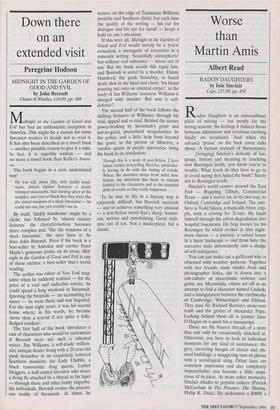Down there on an extended visit
Peregrine Hodson
MIDNIGHT IN THE GARDEN OF GOOD AND EVIL by John Berendt Chatto & Windus, £10.99, pp. 388 Midnight in the Garden of Good and Evil has had an enthusiastic reception in America. This might be a reason for some Spectator readers to decide not to read it. It has also been described as a travel book — another possible reason to give it a miss. In fact, it is superbly written — and no more a travel book than Kafka's Ameri- ca.
The book begins in a cool, understated way:
He was tall, about fifty, with darkly hand- some, almost sinister features: a neatly trimmed moustache, hair turning silver at the temples, and eyes so black that they were like the tinted windows of a sleek limousine — he could see out, but you couldn't see in.
By itself, 'darkly handsome' might be a clich6, but followed by 'almost sinister features' the characterisation becomes more complex and, 'like the windows of a sleek limousine', the eyes have it. So does John Berendt. Even if his book is a best-seller in America and carries Peter Mayle's generous praise on its cover, Mid- night in the Garden of Good and Evil is one of those rarities: a best-seller that's worth reading. The author was editor of New York mag- azine when he suddenly realised — for the price of a veal and radicchio entrée, he could spend a long weekend in Savannah. Ignoring the bromide — 'no accounting for tastes' — he went there and was beguiled. For the next eight years, it was his second home where, in his words, he became `more than a tourist if not quite a fully- fledged resident'. The first half of the book introduces a cast of characters who would be caricatures if Berendt were not such a talented writer. Jim Williams, a self-made million- aire antique dealer living with a 20-year-old punk houseboy in an exquisitely restored Southern mansion; the Lady Chablis, a black transvestite drag queen; Luther Driggers, a half-crazed inventor who wears a living fly attached by a thread to his lapel — through these and other lushly improba- ble individuals, Berendt evokes the precari- ous reality of Savannah. At times, he teeters on the edge of Tennessee Williams pastiche and Southern cliché, but each time the quality of the writing — his car for dialogue and his eye for detail — keeps a hold on one's attention.
If this were all, Midnight in the Garden of Good and Evil would merely be a lyrical evocation, a menagerie of eccentrics in a romantic setting: 'beautifully atmospheric' but without real substance — seven out of ten, But the book avoids this tepid fate, and Berendt is saved by a murder. Danny Hansford, the punk houseboy, is found dead, shot in the head and chest, 'his blood pouring out onto an oriental carpet', in the study of Jim Williams' mansion. Williams is charged with murder, But was it self- defence?
The second half of the book follows the shifting fortunes of Williams, through his trial, appeal and re-trial. Behind the scenes power-broking by Savannah's great and not-so-good, procedural irregularities by the police, and a little help from beyond the grave in the person of Minerva, a voodoo queen in purple spectacles, bring the book to its conclusion:
Though this is a work of non-fiction, I have taken certain storytelling liberties, particular- ly having to do with the timing of events. Where the narrative strays from strict non- fiction, my intention has been to remain faithful to the characters and to the essential drift of events as they really happened.
To be true to life in a literary way is extremely difficult, but Berendt succeeds — and so achieves something very unusual — a non-fiction novel that's sharp, humor- ous, serious and entertaining. Great style: nine out of ten. Not a masterpiece, but a classic.


























































 Previous page
Previous page